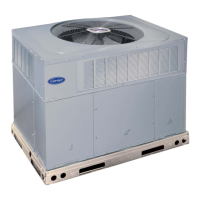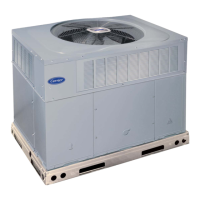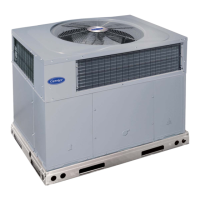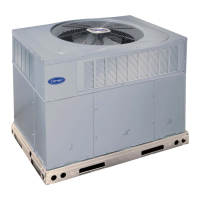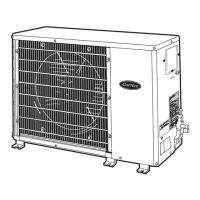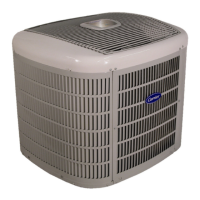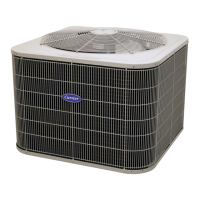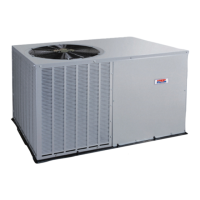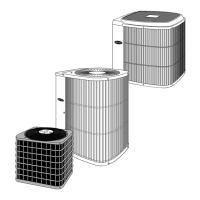Introduction
This packaged heat pump is fully self-contained and designed for
outdoor installation (See Fig. 1). See Fig. 2 and Fig. 3 for unit
dimensions. All unit sizes have discharge openings for both horizontal
and downflow configurations, and are factory shipped with all downflow
duct openings covered. The unit may be installed either on a rooftop or
on a ground-level cement slab. (See Fig. 4 for roof curb dimensions.)
Receiving and Installation
Step 1 – Check Equipment
Identify Unit
The unit model number and serial number are printed on the unit
informative plate. Check this information against shipping papers.
Inspect Shipment
Inspect for shipping damage before removing packaging materials. If
unit appears to be damaged or is torn loose from its anchorage, have it
examined by transportation inspectors before removal. Forward claim
papers directly to transportation company. Manufacturer is not
responsible for any damage incurred in transit. Check all items against
shipping list. Immediately notify the nearest equipment distribution
office if any item is missing. To prevent loss or damage, leave all parts in
original packages until installation.
If the unit is to be mounted on a curb in a downflow application, review
Step 7 to determine which method is to be used to remove the downflow
panels before rigging and lifting into place. The panel removal process
may require the unit to be on the ground.
Step 2 – Provide Unit Support
IMPORTANT: The unit must be secured to the curb by installing
screws through the bottom of the curb flange and into the unit base rails.
When installing large base units onto the common curb, the screws must
be installed before allowing the full weight of the unit to rest on the curb.
A minimum of six screws are required for large base units. Failure to
secure unit properly could result in an unstable unit. See Warning near
Rigging/Lifting information and accessory curb instructions for more
details.
For hurricane tie downs, contact distributor for details and PE
(Professional Engineering) Certificate if required.
Roof Curb
Install accessory roof curb in accordance with instructions shipped with
curb (See Fig. 4). Install insulation, cant strips, roofing, and flashing.
Ductwork must be attached to curb.
IMPORTANT: The gasketing of the unit to the roof curb is critical for a
water tight seal. Install gasketing material supplied with the roof curb.
Improperly applied gasketing also can result in air leaks and poor unit
performance.
Curb should be level to within 1/4 in. (6.35 mm) (See Fig. 6). This is
necessary for unit drain to function properly. Refer to accessory roof
curb installation instructions for additional information as required.
Installation on older “G” series roof curbs.
Two accessory kits are available to aid in installing a new “G” series unit
on an old “G” roof curb.
1. Accessory kit number CPADCURB001A00, (small chassis) and
accessory kit number CPADCURB002A00, (large chassis) includes
roof curb adapter and gaskets for the perimeter seal and duct
openings. No additional modifications to the curb are required
when using this kit.
2. An alternative to the adapter curb is to modify the existing curb by
removing the outer horizontal flange and use accessory kit number
CPGSKTKIT001A00 which includes spacer blocks (for easy
alignment to existing curb) and gaskets for the perimeter seal and
duct openings. This kit is used when existing curb is modified by
removing outer horizontal flange.
WARNING
!
ELECTRICAL SHOCK HAZARD
Failure to follow this warning could result in personal injury or death.
Before installing or servicing system, always turn off main power to
system and install lockout tag. There may be more than one disconnect
switch. Turn off accessory heater power switch if applicable.
WARNING
!
PERSONAL INJURY AND ENVIRONMENTAL HAZARD
Failure to relieve system pressure could result in personal injury and/or
death.
1. Relieve pressure and recover all refrigerant before servicing
existing equipment, and before final unit disposal. Use all
service ports and open all flow-control devices, including
solenoid valves.
2. Federal regulations require that you do not vent refrigerant into
the atmosphere. Recover during system repair or final unit
disposal.
CAUTION
!
CUT HAZARD
Failure to follow this caution may result in personal injury.
When removing access panels (see Fig. 22) or performing maintenance
functions inside your unit, be aware of sharp sheet metal parts and
screws. Although special care is taken to reduce sharp edges to a
minimum, be extremely careful and wear appropriate protective
clothing, safety glasses and gloves when handling parts or reaching into
the unit.
WARNING
!
PERSONAL INJURY AND PROPERTY DAMAGE
HAZARD
For continued performance, reliability, and safety, the only approved
accessories and replacement parts are those specified by the equipment
manufacturer. The use of non-manufacturer approved parts and
accessories could invalidate the equipment limited warranty and result
in fire risk, equipment malfunction, and failure. Please review
manufacturer's instructions and replacement part catalogs available
from your equipment supplier.
NOTICE
!
If the unit gasketing or insulation must be replaced, ensure the material
used is compliant with the two agency requirements listed.
1. Insulation and adhesives shall meet NFPA 90.1 requirements for
flame spread and smoke generation.
2. Cabinet insulation shall meet ASHRAE Standard 62.2.
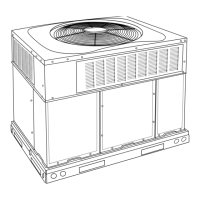
